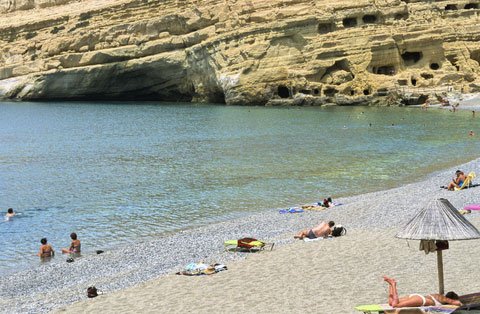Phaistos (sometimes spelt Phaestos, Faistos or Festos) is not as well known as Knossos. It was excavated by an Italian team at the same time as Arthur Evans was digging at Knossos. Evans was very good at what we now call public relations, and so Knossos made far more headlines. He also renovated many of the rooms, which makes them far more interesting for casual visitors.
In contrast, nothing in Phaistos remains above the ground floor. But what it may lack in restored features it makes up for in its location. The views of the surrounding countryside especially over the Messara plain are magnificent.
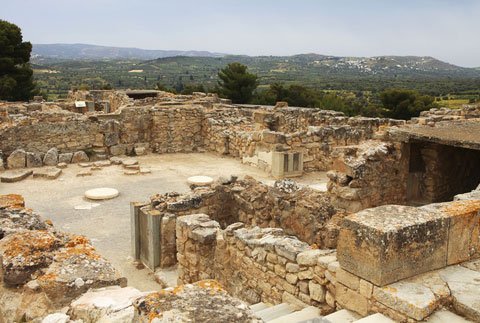
A palace with a view
Phaistos consists of two palaces. The first old palace was built around 1900 BC, and was destroyed by an earthquake in 1700 BC. The much larger new palace was then built, overlapping the old and extending to the east. The whole complex was then gutted by fire in 1450 BC.
As you approach the site by road and park your vehicle, you’d be forgiven for thinking there’s nothing much to see. The ticket office isn’t very inspiring, and the shop sells the usual tourist souvenirs. Going down the path you’ll see bits and pieces of the old Minoan town which lay close to the palace. The path takes you down to the West Court where you can see the west facade of the palace.
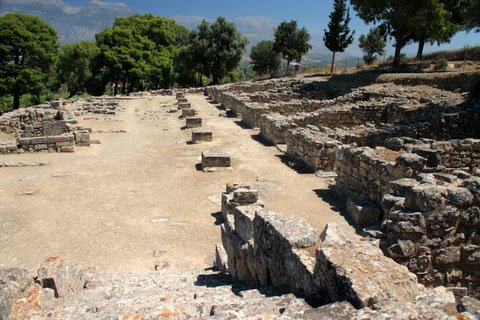
Monumental staircase
From the West Court you go up what is known as the Monumental staircase. This leads to some of the living apartments and large store complexes. As with all Minoan sites, large storage pots (pithoi) were used to store grain and oil. Seals made of clay were used to indicate ownership of the commodities stored. Over 300 different ones have been found.
Central court
This a the largest of the courts, and archaeologists believe it was situated so that Mount Ida could be seen to the north. There is a cave at Kamares which it is thought was important in the religious life of the Minoans.
The private palace living quarters lie to the north of the court, and you can see the drainage channel which lies along the side of the narrow passageway which lead to the rooms. Then you come to the North court, where the remains of a small garden have been found.
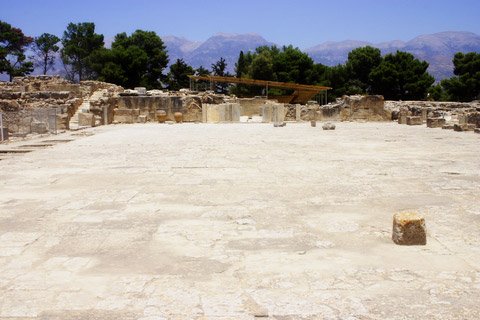
Phaistos Disk
Further on from the North Court are some rooms dating from the time of the Old Palace. It was in one of these rooms that the famous Phaestos Disk was discovered. The disk is made from baked clay, and is covered on both sides in hieroglyphs. They are arranged in a spiral pattern. So far experts have been unable to decipher the strange signs.
Some experts say that there is simply not enough information to enable anyone to decipher the disk. If they had more of them they might have some success. Because of its size and the arrangement of the hieroglyphs, the suggestion has been made that the disk has some religious function. See new theory for interpretation advanced in 2021 that also links the disc with Aphrodite temple in Acrocorinth.
The disk may be seen at the National Museum in Heraklion and a photo seen on our page here.
Agia Triada
Although not often mentioned, there is another important Minoan site on the west of the same hill where Phaistos lies. Because no one knows the name the Minoans called it, the site is named after a local church.
There is still some debate as to the function of this site. Because some very find frescos were found it is thought it might have been a villa for the ruling family. Three famous stone vases were also found here, and you can see them in the Archaeological Museum in Heraklion. They are known as the Boxer Rhyton, the Chieftain Cup and the Harvester Vase.
Another reason why it’s thought this was a luxury villa is the view. The structure is on a slope with wonderful views towards Mesara Bay. There is some evidence that the sea was once much closer to this hill, in which case the view would have been even better than it is today.
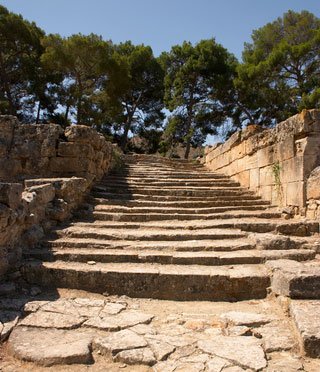
Time for a swim?
If you’ve had enough of ancient sites and old stones, why not go on south for a few kilometers to Matala? Lie on the beach, or have a swim. Take a look at the caves where the sixties’ hippies hung out…
